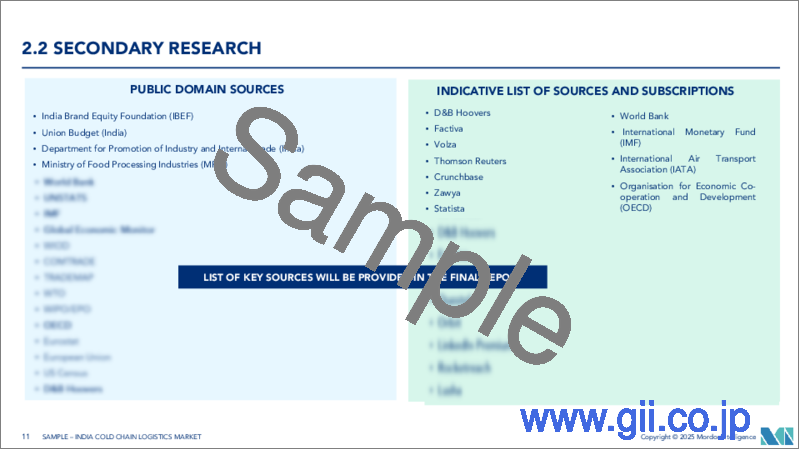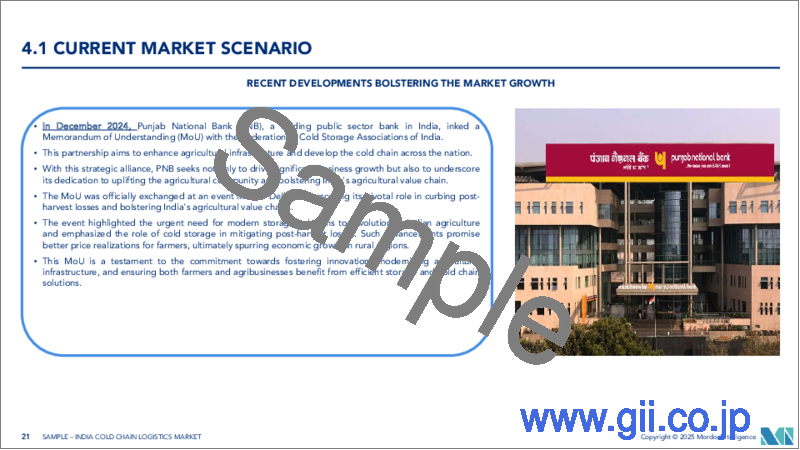|
|
市場調査レポート
商品コード
1689844
インドのコールドチェーン物流- 市場シェア分析、産業動向と統計、成長予測(2025年~2030年)India Cold Chain Logistics - Market Share Analysis, Industry Trends & Statistics, Growth Forecasts (2025 - 2030) |
||||||
カスタマイズ可能
適宜更新あり
|
|||||||
| インドのコールドチェーン物流- 市場シェア分析、産業動向と統計、成長予測(2025年~2030年) |
|
出版日: 2025年03月18日
発行: Mordor Intelligence
ページ情報: 英文 100 Pages
納期: 2~3営業日
|
全表示
- 概要
- 目次
インドのコールドチェーン物流市場規模は2025年に127億7,000万米ドルと推定され、予測期間(2025~2030年)のCAGRは9.72%で、2030年には203億1,000万米ドルに達すると予測されます。

主要ハイライト
- 生鮮品需要の高まりが市場成長を後押ししています。消費者行動の変化により、eコマースや医薬品のオンラインショッピングが市場を牽引しています。
- インドのコールドチェーン産業はまだ黎明期にあり、コールドチェーン倉庫物流産業において最も有望なセグメントのひとつとなっています。インドは2027年までに世界第5位の経済大国になる勢いです。世界市場で確固たる地位を築いている重要な参入企業として、インドのサプライチェーンインフラへの投資は年々増加すると予想されています。幸いなことに、インド政府はコールドチェーン産業開発の推進力となっており、さまざまな補助金制度や助成金を通じて民間の参入を促しています。食品加工産業省(MoFPI)は、コールドチェーン、付加価値、保存インフラに特化したプログラムを立ち上げました。
- インドは世界最大の牛乳生産国、世界第2位の果物・野菜生産国であり、魚介類、肉類、鶏肉の生産量も多いです。しかし、コールドチェーン供給が未熟なため、食品や農産物が著しく失われています。国連食糧農業機関によると、年間約13億トンの食糧が失われ、食糧生産量の3分の1を占めています。これらの損失は、年間80億米ドルから150億米ドルに上ると推定されています。こうした問題を回避するためには、コールドチェーンセグメントの開発が必要です。生鮮食品以外に、医薬品産業も信頼性の高いコールド・サプライチェーンネットワークに依存する重要なセグメントです。ワクチンの保管と輸送、救命薬、その他の製薬原料は、堅牢で管理の行き届いたコールドサプライチェーンネットワークにつながっています。
- 2023年12月、インド政府は腐敗しやすい園芸農産物の冷蔵倉庫を設置するためのさまざまなスキームを実施する予定で、このスキームでは全国で資金援助が受けられます。農業セクタは、国内のコールドチェーンインフラによってパラダイムシフトを経験しています。同じ方向を目指して、インド政府は生鮮園芸作物用の冷蔵倉庫を設置するための様々なスキームを実施しており、そのための資金援助は全国で利用可能です。
- これらの制度は需要や起業家主導のもので、政府は信用連動型補助金という形で支援し、一般地域ではプロジェクト費用の35%、中山間地域や特定地域では50%を、それぞれの州園芸局(SHM)を通じて記載しています。この取り組みは、農業や園芸作物への被害を避けることを目的としています。また、園芸総合開発ミッション(MIDH)のもと、冷蔵倉庫のほか、予冷庫、冷蔵室、パックハウス、統合パックハウス、保存庫、冷凍輸送、熟成庫の設置にも資金援助が提供されます。
- 国連食糧農業機関によると、年間生産される食料の3分の1、約13億トンが失われています。これらの損失は、推定によると年間80億米ドルから150億米ドルにのぼるといいます。こうした問題を防ぐためには、インドでコールドチェーン産業が成長しなければならないです。
インドのコールドチェーン物流市場動向
チルド部門は今後大きな勢いを増す
- コールドチェーン保管施設へのニーズの拡大と、アイスクリーム、肉、魚介類などの冷凍商品タイプの増加が、コールドチェーン市場を前進させています。
- 冷凍食品は食品をより不活性にすることで保存期間を長くするため、コールドチェーン物流市場の冷凍セグメントは予測期間中に急成長が見込まれます。
- チルド食品は、安全上または品質上の理由から、その寿命を通じて冷蔵温度(80℃以下、50℃を目標)で保存されるよう設計されています。
- この冷凍方法は、食品を腐敗させ賞味期限を制限する生物学的・化学的プロセスを遅らせるのに役立ちます。冷凍食品はチルド食品よりも栄養価が高く、食欲をそそる。利便性へのニーズが、冷凍食品に対する消費者の需要を高めています。
- 国連食糧農業機関(FAO)によると、食品ロスの40%以上は、特に貧しい国々では、ポストハーベストと加工中に発生しています。このため、これらの国々の食糧供給を約15%(2億5,000万トン以上)増加させることができる、長期的でエネルギー効率の高いコールドチェーンの確立が必要となります。
アジア太平洋が大きな市場シェアを占めると予想される
- インドは果実と野菜の世界第2位の生産国で、世界生産に占めるシェアはそれぞれ11.38%と11.78%です。インドはマンゴー、バナナ、グアバ、パパイヤ、レモン、ライム、オクラの最大の生産国であり、ジャガイモ、トマト、タマネギ、キャベツ、カリフラワー、ブリンジャールの第2位の生産国です。ICAR-中央ポストハーベスト技術ラボ(CIPHET)が実施した調査によると、インドでは、果物や野菜のポストハーベスト・ロスは、国内の園芸生産量の4.58~15.88%であると指摘しています。インド政府は、園芸総合開発ミッション(MIDH)を通じて、面積の拡大、苗床の開発、養殖池の建設を可能にしました。
- 情報源によると、食用穀物生産量は過去10年間一貫して伸びており、2012-13年の2億5,710万トンから2021~22年には3億1,560万トンとなります。2022~23年の食用穀物生産量は、過去5年間の平均を3,080万トン上回ります。果物の生産量は、2021~22年の1億751万トンに対し、2022~23年は1億834万トンと推定されます。野菜の生産量は、2021~22年の2億914万トンに対し、2022~23年は2億1,291万トンと推定されます。
- インドはバナナ、パパイヤ、マンゴー、グアバ、ショウガ、オクラの生産で世界をリードしています。2021~2022年にかけて、インドは15億2,760万米ドル相当の生鮮果物と野菜を輸出し、その内訳は果物が7億5,070万米ドル相当、野菜が7億6,701万米ドル相当でした。インドは主に近隣諸国、すなわちアラブ首長国連邦、バングラデシュ、パキスタン、サウジアラビア、スリランカ、ネパールに輸出しています。
インドのコールドチェーン物流産業概要
インドのコールドチェーン物流市場は細分化された市場であり、需要の拡大に対応するため、多数の地元企業が存在します。同市場の大手企業には、Gati Kausar India Pvt. Ltd、Snowman Logistics Pvt. Ltd、ColdEx Logistics Pvt. Ltd、Stellar Value Chain Solutions Pvt. Ltdなどがあります。サプライチェーンの合理化に投資し、先進的技術を持つ企業は、市場で高いシェアを獲得する上で有利です。さらに、世界企業は現地企業と提携して市場に投資し、利益を得ることができます。
その他の特典
- エクセル形式の市場予測(ME)シート
- 3ヶ月間のアナリストサポート
目次
第1章 イントロダクション
- 調査の前提条件
- 調査範囲
第2章 調査手法
- 分析方法
- 調査フェーズ
第3章 エグゼクティブサマリー
第4章 市場力学
- 現在の市場シナリオ
- 市場力学
- 促進要因
- 都市化とライフスタイルの変化
- 小売店における組織化食品の増加
- 製薬産業からの需要増加
- 抑制要因
- 十分なインフラの欠如
- 機会
- 有利な政府施策
- 生鮮貿易の増加
- 促進要因
- バリューチェーン/サプライチェーン分析
- 産業の魅力-ポーターのファイブフォース分析
- 新規参入業者の脅威
- 買い手/消費者の交渉力
- 供給企業の交渉力
- 代替品の脅威
- 競争企業間の敵対関係
- 技術動向と自動化
- 政府の規制と取り組み
- 環境・温度管理保管への注目
- 排出基準と規制がコールドチェーン産業に与える影響
- COVID-19の市場への影響
第5章 市場セグメンテーション
- サービス別
- 保管
- 輸送
- 付加価値サービス(ブラスト凍結、ラベリング、在庫管理など)
- 温度タイプ別
- 冷蔵
- 冷凍
- 用途別
- 園芸(生鮮果物・野菜)
- 乳製品(牛乳、アイスクリーム、バターなど)
- 肉、魚、鶏肉
- 加工食品
- 製薬、ライフサイエンス、化学
- その他
第6章 競合情勢
- 市場集中概要
- 企業プロファイル
- Gati Kausar India Pvt Ltd
- Snowman Logistics Pvt Ltd
- ColdEx Logistics Pvt Ltd
- Stellar Value Chain Solutions Pvt Ltd
- TCI Express
- Future Supply Chain Solutions
- M.J. Logistics Services Ltd
- Fresh and Healthy Services Ltd
- R.K. Foodland Private Ltd
- Gubba Cold Storages Ltd
- Cold Star Logistics Pvt Ltd*
- その他の企業
第7章 市場機会と今後の動向
第8章 付録
The India Cold Chain Logistics Market size is estimated at USD 12.77 billion in 2025, and is expected to reach USD 20.31 billion by 2030, at a CAGR of 9.72% during the forecast period (2025-2030).

Key Highlights
- The rising demand for perishable goods has been propelling market growth. Due to a shift in consumer behavior, e-commerce and online pharmaceutical shopping are driving the market.
- The Indian cold chain industry is still in its infancy, making it one of the most promising fields in the cold chain warehousing and logistics industry. India is on track to become the world's fifth-largest economy by 2027. As a well-established key player in the global market, investment in India's supply chain infrastructure is expected to rise year on year. Fortunately, the Indian government is a driving force in developing the cold chain industry, and it encourages private participation through various subsidy schemes and grants. The Ministry of Food Processing Industries (MoFPI) launched a program dedicated to cold chain, value addition, and preservation infrastructure.
- India is the world's largest producer of milk and the second-largest producer of fruits and vegetables, and it produces a significant amount of seafood, meat, and poultry. However, due to the inexperienced cold chain supply, food and agricultural products are significantly lost. According to the Food and Agriculture Organization, approximately 1.3 billion tonnes of food are lost yearly, accounting for one-third of total food production. These losses are estimated to be between USD 8 and USD 15 billion annually. To avoid these issues, the cold chain sector must be developed. Aside from perishable food, the pharmaceutical industry is another critical sector that relies on a reliable cold supply chain network. Vaccine storage and transportation, life-saving drugs, and other pharma raw materials led to a robust and well-managed cold supply chain network.
- In December 2023, the Indian government is implementing various schemes for setting up cold storage for perishable horticultural produce, under which financial assistance will be available throughout the country. The agricultural sector is witnessing a paradigm shift with its cold chain infrastructure in the country. Aiming in the same direction, the Indian government is implementing various schemes for setting up cold storage for perishable horticultural produce, for which financial assistance is available throughout the country.
- The components are demand/entrepreneur driven, for which the government assists in the form of credit-linked subsidy, providing 35% of the project cost in general areas and 50% in hilly and scheduled areas through respective State Horticulture Missions (SHMs). The initiative is aimed at avoiding damage to agriculture and horticultural produce. Besides cold storage, financial assistance is also provided for setting up a pre-cooling unit, cold room, pack houses, integrated pack house, preservation unit, reefer transport, and ripening chamber under the Mission for Integrated Development of Horticulture (MIDH).
- According to the Food and Agriculture Organization, one-third, or around 1.3 billion tonnes, of all food produced annually is lost. These losses cost USD 8 to 15 billion annually, according to estimates. To prevent these issues, the cold chain industry must grow in India.
India Cold Chain Logistics Market Trends
Chilled Segment is Gaining Huge Momentum in the Coming Years
- The expanding need for cold chain storage facilities and the increasing varieties of frozen commodities such as ice cream, meat, and seafood are moving the cold chain market ahead.
- Because frozen food products lengthen the storage time of foods by rendering them more inert, the frozen sector of the cold chain logistics market is expected to grow quickly during the projected period.
- Chilled foods, for safety or quality reasons, are designed to be stored at refrigeration temperatures (at or below 80C, targeting 50C) throughout their life.
- This method of freezing aids in slowing biological and chemical processes that cause food to decay and limit its shelf life. Frozen food has more nutrients than chilled food, which makes it more appetizing. The need for convenience is driving up consumer demand for frozen foods.
- According to the United Nations Food and Agricultural Organization (FAO), more than 40% of food losses occur during post-harvesting and processing, particularly in poor nations. This necessitates the establishment of long-term, energy-efficient cold chains capable of increasing food supply in these nations by about 15%, or over 250 million tons.
Asia-Pacific is Expected to Hold Significant Market Share
- India is the second-largest producer of fruits and vegetables, with its share in world production at 11.38% and 11.78%, respectively. India is the largest producer of mango, banana, guava, papaya, lemon, lime, and okra and the second-largest producer of potato, tomato, onion, cabbage, cauliflower, and brinjal. A study conducted by the ICAR-Central Institute of Post-Harvest Engineering & Technology (CIPHET) points out that in India, for fruits and vegetables, the post-harvest losses range from 4.58 to 15.88% of the country's horticulture production. The Government of India, through the Mission for Integrated Development of Horticulture (MIDH), has enabled area expansion, the development of nurseries, and the construction of farm ponds.
- According to the sources, food grain output has consistently grown over the last decade from 257.1 million tons in 2012-13 to 315.6 million tons in 2021-22. Food grain production in 2022-23 is 30.8 million tons higher than the previous five years' average. Fruit production is estimated to be 108.34 million tonnes in the year 2022-23 as compared to 107.51 million tonnes in the year 2021-22. The production of vegetables is estimated to be 212.91 million tonnes in the year 2022-23 compared to 209.14 million tonnes in the year 2021-22.
- India leads the world in the production of banana, papaya, mango, and guava, along with ginger and okra. During 2021-2022, India exported fresh fruits and vegetables worth USD 1.527.60 million, which comprised fruits worth USD 750.7 million and vegetables worth USD 767.01 million. India mostly exports to its neighbors, namely the UAE, Bangladesh, Pakistan, Saudi Arabia, Sri Lanka, and Nepal.
India Cold Chain Logistics Industry Overview
The Indian cold chain logistics market is fragmented in nature, with the presence of a large number of local players attending to the growing demand. Some of the major players in the market include Gati Kausar India Pvt. Ltd, Snowman Logistics Pvt. Ltd, ColdEx Logistics Pvt. Ltd, and Stellar Value Chain Solutions Pvt. Ltd, among others. Companies investing in streamlining the supply chain and having advanced technology have an edge in getting a good share of the market. Furthermore, global players can partner with local companies to invest in the market and gain profits.
Additional Benefits:
- The market estimate (ME) sheet in Excel format
- 3 months of analyst support
TABLE OF CONTENTS
1 INTRODUCTION
- 1.1 Study Assumptions
- 1.2 Scope of the Study
2 RESEARCH METHODOLOGY
- 2.1 Analysis Method
- 2.2 Research Phases
3 EXECUTIVE SUMMARY
4 MARKET INSIGHTS DYNAMICS
- 4.1 Current Market Scenario
- 4.2 Market Dynamics
- 4.2.1 Drivers
- 4.2.1.1 Urbanization and Changes in Lifestyles
- 4.2.1.2 Increased Organized Food in Retail Stores
- 4.2.1.3 Increasing Demand from the Pharmaceutical Industry
- 4.2.2 Restraints
- 4.2.2.1 Lack of Sufficient Infrastructure
- 4.2.3 Opportunities
- 4.2.3.1 Favourable Government Policies
- 4.2.3.2 Increasing Perishable Trade
- 4.2.1 Drivers
- 4.3 Value Chain / Supply Chain Analysis
- 4.4 Industry Attractiveness - Porter's Five Forces Analysis
- 4.4.1 Threat of New Entrants
- 4.4.2 Bargaining Power of Buyers/Consumers
- 4.4.3 Bargaining Power of Suppliers
- 4.4.4 Threat of Substitute Products
- 4.4.5 Intensity of Competitive Rivalry
- 4.5 Technological Trends and Automation
- 4.6 Government Regulations and Initiatives
- 4.7 Spotlight on Ambient/Temperature-controlled Storage
- 4.8 Impact of Emission Standards and Regulations on Cold Chain Industry
- 4.9 Impact of COVID-19 on the Market
5 MARKET SEGMENTATION
- 5.1 By Service
- 5.1.1 Storage
- 5.1.2 Transportation
- 5.1.3 Value-added Services (Blast Freezing, Labeling, Inventory Management, etc.)
- 5.2 By Temperature Type
- 5.2.1 Chilled
- 5.2.2 Frozen
- 5.3 By Application
- 5.3.1 Horticulture (Fresh Fruits & Vegetables)
- 5.3.2 Dairy Products (Milk, Ice-cream, Butter, etc.)
- 5.3.3 Meats, Fish, Poultry
- 5.3.4 Processed Food Products
- 5.3.5 Pharma, Life Sciences, and Chemicals
- 5.3.6 Other Applications
6 COMPETITIVE LANDSCAPE
- 6.1 Market Concentration Overview
- 6.2 Company Profiles
- 6.2.1 Gati Kausar India Pvt Ltd
- 6.2.2 Snowman Logistics Pvt Ltd
- 6.2.3 ColdEx Logistics Pvt Ltd
- 6.2.4 Stellar Value Chain Solutions Pvt Ltd
- 6.2.5 TCI Express
- 6.2.6 Future Supply Chain Solutions
- 6.2.7 M.J. Logistics Services Ltd
- 6.2.8 Fresh and Healthy Services Ltd
- 6.2.9 R.K. Foodland Private Ltd
- 6.2.10 Gubba Cold Storages Ltd
- 6.2.11 Cold Star Logistics Pvt Ltd*
- 6.3 Other Companies





